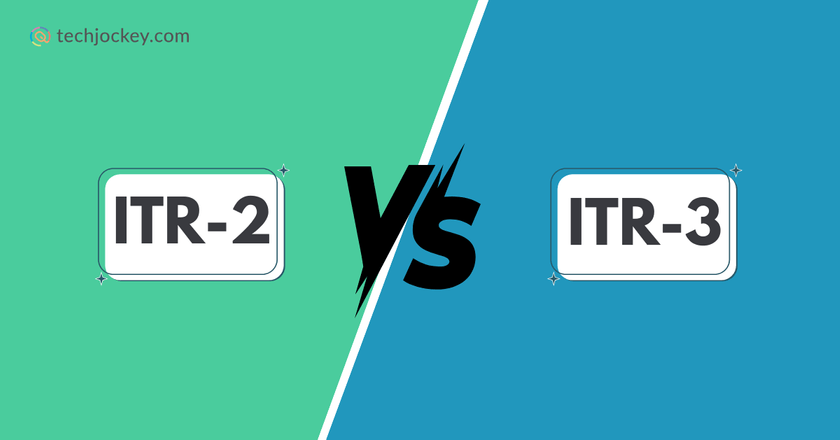ITR-2 vs ITR-3: Key Differences Every Taxpayer Must Know

Taxpayers frequently experience confusion in selecting the form when they are filing an Income Tax Return in India. Of all the ITR types, the ITR-2 and ITR-3 are the most common ones, and individuals, and Hindu Undivided Families (HUFs) use them.
They may appear to be the same at first, but these have important differences in terms of eligibility, income sources covered, and filing requirements. Using the wrong ITR form may result in notices, or rejection or penalties, and it is important to know the difference.
In this blog, we are going to discuss ITR-2 vs ITR-3 and who should file each, their main features and a comparison between the two so that you can decide on the right form to file in your case.
What is ITR-2?
ITR-2 is applicable to individuals and HUFs without business and profession income. That is, it applies to taxpayers who have their sources of income as:
- Salary or pension
- House property (single or more than one)
- Capital gains (long-term and short-term)
- Other sources include interest income, lottery, betting, etc
- Foreign assets and income
ITR-2 is suitable in the case of salaried people, professionals whose earned income is not considered as a business, and those whose investments yield capital gains.
Example: In case you are a salaried employee and you have several house properties, dividends, and share selling profits, you are expected to file ITR-2.
Suggested Read: How to File ITR-2: Step by Step Guide
What is ITR-3?
ITR-3 is aimed at individuals and HUFs earning from business or profession. This consists of proprietorship businesses and professional income both. It also addresses other sources of income, just like ITR-2.
Eligible income categories under ITR-3:
- Business or professional income (proprietorship, consultancy, freelancing, etc.)
- Salary/pension income
- House property income
- Capital gains
- Other sources (interest, dividends, etc.)
- Foreign assets and income
Example: If you run a consultancy firm, do intraday trading, or freelance as a software developer, you should file ITR-3.
Suggested Read: How to File ITR-3: Step by Step Guide
Key Differences Between ITR-2 and ITR-3
Both forms ITR-2 vs ITR-3 are for individuals and HUFs. But the main difference is in business/professional income. Let’s have a look at a detailed comparison.
Eligibility
- ITR-2: For individuals or HUFs with no business or professional income.
- ITR-3: For individuals or HUFs with business or professional income.
Income Sources Covered
- ITR-2: Salary, multiple house properties, capital gains, other income, foreign assets.
- ITR-3: Business/professional income + all income sources covered under ITR-2.
Intraday Trading & Speculative Income
- ITR-2: Cannot be used for declaring intraday trading or speculative income.
- ITR-3: Mandatory for intraday trading, derivatives (F&O), or speculative transactions.
Nature of Filing
- ITR-2: More suitable for salaried individuals or investors.
- ITR-3: More complex, requiring profit and loss accounts, balance sheets, and an audit (if applicable).
Presumptive Taxation
- ITR-2: Not applicable.
- ITR-3: Taxpayers eligible for Presumptive Taxation (Sections 44AD, 44ADA, 44AE) can file under ITR-3.
Comparison Table: ITR-2 vs ITR-3
| Criteria | ITR-2 | ITR-3 |
|---|---|---|
| Applicable To | Individuals & HUFs without business/professional income | Individuals & HUFs with business/professional income |
| Salary/Pension | Yes | Yes |
| House Property | Yes (single/multiple) | Yes (single/multiple) |
| Capital Gains | Yes | Yes |
| Other Income (interest, lottery, etc.) | Yes | Yes |
| Intraday Trading/Derivatives | Not allowed | Allowed |
| Presumptive Taxation | No | Yes |
| Complexity | Simple | Detailed with financial statements |
Examples to Understand Better
The following are examples to get a better understanding.
Case 1: Rohan is a professional earning a salary and two flats in terms of rent and investments in stocks as capital gains. He should file ITR-2.
Case 2: Priya is a freelance graphic designer with a source of income obtained through her clients as well as dividends and mutual fund returns. She is supposed to submit ITR-3 since she has professional income.
Case 3: Arjun is an intraday trader who gets speculative income in addition to his salary. He is supposed to submit ITR-3 because the trading is assumed to be business income.
Documents Required for ITR-2 and ITR-3
Although the forms are different, the basic documents needed are similar
- PAN card
- Aadhaar card
- Form 16 (for salaried individuals)
- Form 26AS & AIS (Annual Information Statement)
- Bank account details
- Salary slips (if applicable)
- Capital gains statements (from mutual funds, shares, property sales)
- Details of house property (rental income, interest on home loan)
- Business/professional income details (for ITR-3) – P&L statement, balance sheet
- Audit reports (if applicable)
Filing Process for ITR-2 vs ITR-3
ITR-2 and ITR-3 are both submitted on the income tax e-filing portal. Here’s how:
- Log in to the Income Tax Portal.
- Tap on File Income Tax Return.
- Choose the assessment year.
- Choose the ITR form to be used (2 or 3).
- Enter the personal and income information.
- Check information, enter necessary documents.
- Preview and confirm.
- E-verify return based on Aadhaar OTP, Net Banking, or Digital Signature.
In case you submit ITR-3, then you might be required to attach balance sheets and profit and loss accounts, which makes it a bit harder than ITR-2.
Why Choose the Right ITR Form?
Filing your return under the wrong form can lead to:
- Rejection of your ITR
- Income Tax Department notices.
- Penalties against non-compliance.
- Wasted time (because you will be required to file again)
This is the reason why it is important to know the difference between ITR-2 vs. ITR-3 before filing.
Final Thoughts
In the case of ITR-2 vs ITR-3, the decision will depend on the source of income. ITR-2 is your thing in case you are a salaried individual whose income is through house property or capital gains, among other investments.
However, ITR-3 would be required in case of any business, professional, or trading income. It is important to study your sources of income and then file. In case of doubts, hire a tax professional or use reliable income tax software to prevent errors.
Submission of the right form not only offers compliance but also enables you to maximize deductions, and unnecessary notice is avoided.
FAQs
What is the difference between ITR-2 and ITR-3?
ITR-2 applies to individuals/HUFs who are not engaged in business/professional income (including trading, freelancing, etc.), whereas ITR-3 applies to those having an income of business/professional income (including trading, freelancing, etc.)
Is ITR-2 or ITR-3 for intraday trading?
Derivatives and intraday trading should be reported under ITR-3 because they are business income.
Who can file ITR-2 & 3?
ITR-2 applies to salaried people, pensioners and investors with capital gains as well as multiple house properties. And ITR-3 is for professionals, freelancers, proprietors and traders having business/professional income.
Mehlika Bathla is a passionate content writer who turns complex tech ideas into simple words. For over 4 years in the tech industry, she has crafted helpful content like technical documentation, user guides, UX content, website content, social media copies, and SEO-driven blogs. She is highly skilled in... Read more








